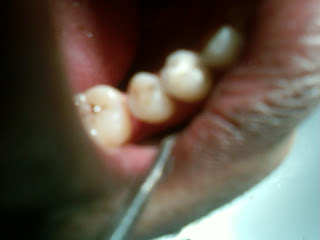THE FOURTH CANAL IN MANDIBULAR FIRST MOLAR- Case reports
by Rukoma A.M. DDS, MDent (Restorative Dentistry)
by Rukoma A.M. DDS, MDent (Restorative Dentistry)
Introduction and literature review
The success rates of root canal treatment among others depend on practitioners’ knowledge of the internal dental/root morphology that allows for accurate location of the canals, proper debridement and cleaning together with adequate obturation of the canals and filling of the access cavity. The use of magnification, adequate lighting and modified access may assist in accurate location of the root canals (Amauri et al., 2006).
Some studies on morphology of mandibular first molars have shown that mandibular first molars have three or four canals, Fabra-Compos, (1985), Walker R. (1988), Zaatar el al,(1997) and Al-Nazhal, (2004). Al-Nazhal in Saudi Arabian sub- population found that, 57.67% of all treated mandibular third molars had four canals, and remaining 42.23%, three canals. The fourth canal was always in the distal root. Al-Nazhal, further found that, the two canals in both mesial and distal roots were confluent in the apical third ending in one foramen. Baugh, and James (2004), have found a case of madibular first molar with five canals (two in distal and three in mesial roots).
Other studies have found these teeth to have up to seven canals. Martinez-Berna and Bandanelli (1985) showed two cases with six canals. Amazingly, Reeh (18) has even reported a case with seven canals, consisting of four canals in the mesial and three in the distal root.
With increasing reports of aberrant canal morphology, dental practitioners need to be extra cautious when dealing with these teeth.
Case report-1
On 30th may, 2011, 26 years female patient reported at our clinic with the main complain of severe toothache not responding to panadol for three days. The pain was disturbing her sleep. On examination, a big and deep cavity on disto-occlusal surfaces of tooth #46 was revealed. Periapical x-ray showed dental pulp exposure.
Upon excavation and access cavity preparation, clearly and separate two root canal orifices were seen in the distal root as well as in the mesial root. The canals were easily penetrated by small K-files (fig.1). the two canals in distal root was located on the buccal and lingual part of the root (fig.2). All canals were prepared and cleaned at working length of 21.5 mm and Master Apical File (MAF) size 35. Obturation was done the same day (single visit technique) and access cavity filled with Glass Ionomer Cement (GIC) and composite. A seven day review show the patient being well, to be reviewed three months later.


Fig.1 k-files in 4 different root canals fig. 2: two k-files in the distal 2 root canals
Case report-2
On 7th june, 2011, a 16-yr-old male patient presented to the dental clinic with a history of severe toothache on the lower right jaw for 2 days. The pain was worse during night hrs and radiating up the same side of her face and ear. Clinical examination revealed a big and deep cavity involving occlusal, buccal and distal surfaces of tooth #46. Periapical x-ray revealed dental pulp exposure with small apical radioluscency around the apex of the distal root of 46.
Root canal treatment was initiated. Taking advantage of the size and location of the cavity, there was direct visualization of the access cavity and orifices of the canals. Two clearly visible canals were seed in the distal root and two in mesial root. In both roots the canals were located on the buccal and lingual sides (fig.3). All canals were easily accessible using k-file #10. The disto-lingual canal was smallest of all canals enlarged up to size 20 (MAF), the rest of the canals were enlarged up to MAF size 35. Obturation of the all canals was done after three days and patient is doing fine to be recalled after 3 months for review.

Fig.3: k-files in the 4 root canals of mandibular 1st molar
Discussion
Seeing the second root canal in distal root of the patient in case report 1was accidental; however, the location of the second distal canal in case 2, was a result of alert from case 1. This observation indicates that there is a possibility of having second root canal in mandibular first molars.
The observation that the reported two cases with four root canals in madibular first molar were just within one week, suggest that, there is substantial number of mandibular first molars with four canals. This is in agreement with Al-Zantal (2004), who said that, “in general the second canal in distal root is the usual normal”.
Conclusion
· There is a greater chance of having 2nd root canal in the mandibular distal root
Recommendations
· Clinicians must always attempt to look for the extra- canals when attending mandibular 1st molars
· Magnification aids are needed when doing root
· Research is needed to find out the number of root canals in mandibular 1st molars
References
1. Al- Nazhal. S, (1999). Incidence of fourth canal in the root canal treated mandibular first molars in Saudi Arabian sub-population, Int Endod J, 32, 49-52
- Amauri F, Fabiana G, Luís C C. (2006) Root canal therapy of a maxillary first molar with five root canals: case report Braz Dent J 17.
3. Baugh, D. and James (2004). Middle Mesial Canal of the Mandibular First Molar: J. Enod 30, 185
4. Fabra-Compos, (1985). Unusual root anatomy of manibular first molar JoE 12, 568-72.
5. Martinez-Bema A and Bandanelli P. (1985). Mandibular first molar with six root canals. J. Endod 11, 348-52
6. Walker R. (1988). Root form and canal anatomy of mandibular first molar in a southern Chinese Population. Endod. and Dent. Traumatol. 4, 19-22
7. Zaatar E I. , Al-Kandari A M , Alhomaidah S, and Al Yasin I M. (1997). Frequency of endodontic treatment in Kuwait: Radiographic evaluation of 846 endodontically treated teeth J Endod 23, 453-456.






